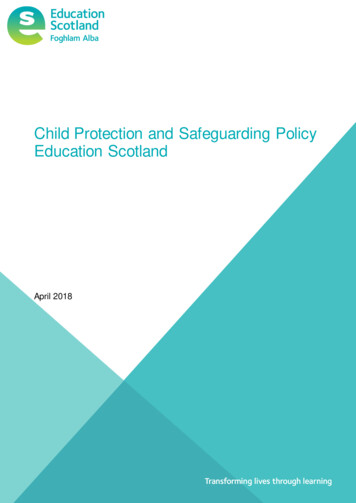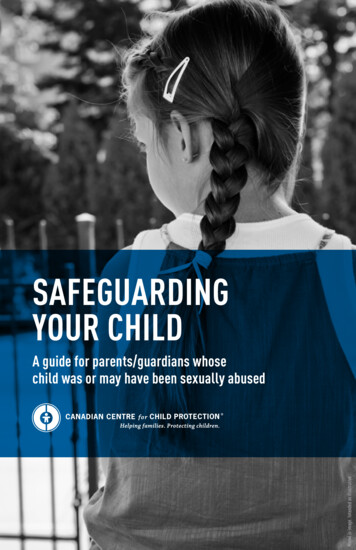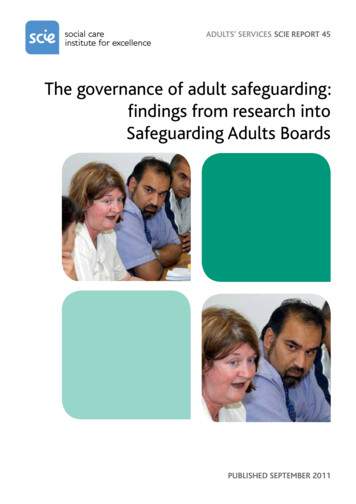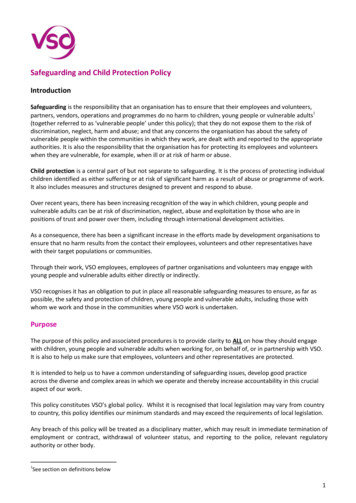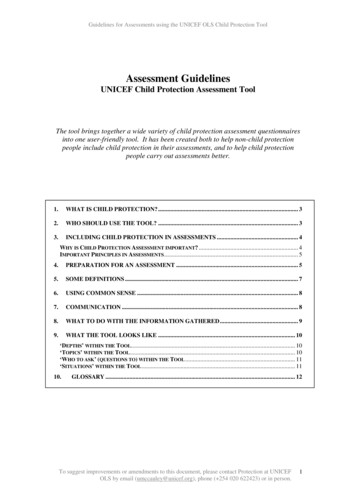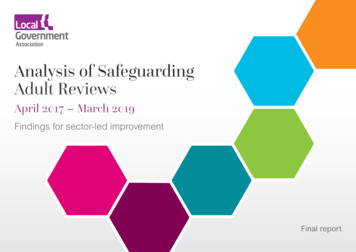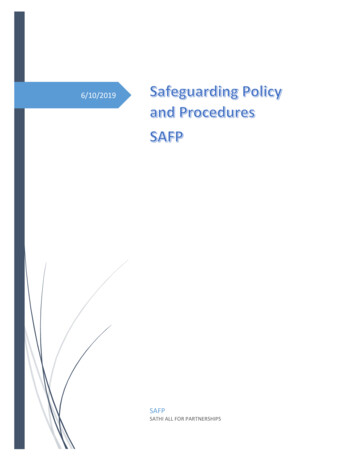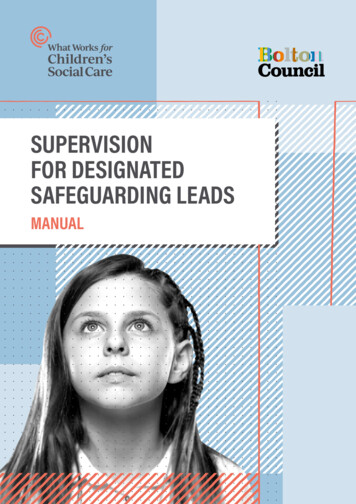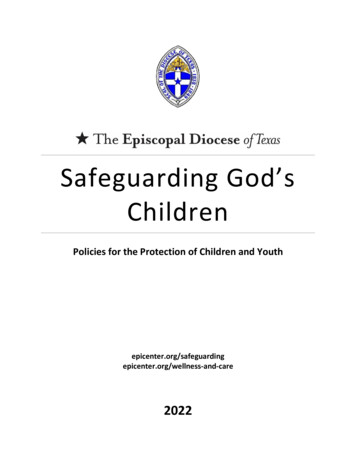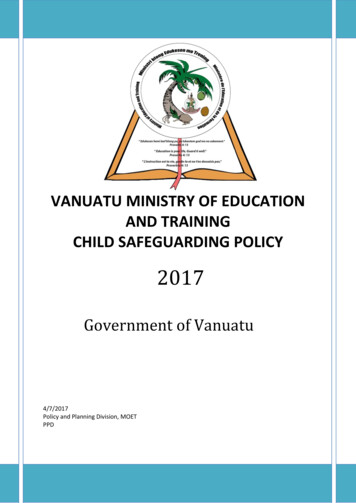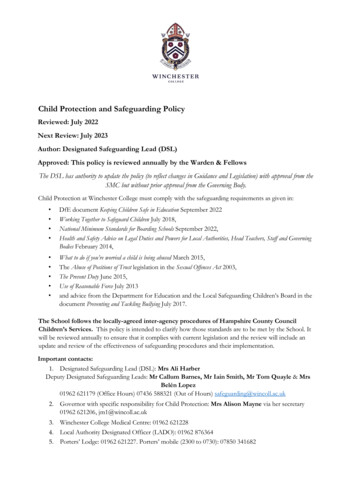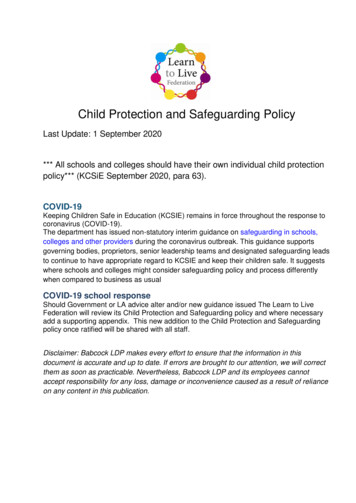
Transcription
Child Protection and Safeguarding PolicyLast Update: 1 September 2020*** All schools and colleges should have their own individual child protectionpolicy*** (KCSiE September 2020, para 63).COVID-19Keeping Children Safe in Education (KCSIE) remains in force throughout the response tocoronavirus (COVID-19).The department has issued non-statutory interim guidance on safeguarding in schools,colleges and other providers during the coronavirus outbreak. This guidance supportsgoverning bodies, proprietors, senior leadership teams and designated safeguarding leadsto continue to have appropriate regard to KCSIE and keep their children safe. It suggestswhere schools and colleges might consider safeguarding policy and process differentlywhen compared to business as usualCOVID-19 school responseShould Government or LA advice alter and/or new guidance issued The Learn to LiveFederation will review its Child Protection and Safeguarding policy and where necessaryadd a supporting appendix. This new addition to the Child Protection and Safeguardingpolicy once ratified will be shared with all staff.Disclaimer: Babcock LDP makes every effort to ensure that the information in thisdocument is accurate and up to date. If errors are brought to our attention, we will correctthem as soon as practicable. Nevertheless, Babcock LDP and its employees cannotaccept responsibility for any loss, damage or inconvenience caused as a result of relianceon any content in this publication.
ContentsSummary of changesPage 4Safeguarding StatementPage 6Key personnelPage 6TerminologyPage 71. IntroductionPage 72. Policy PrinciplesPage 73. Policy AimsPage 84. ValuesPage 85. Safe School, Safe StaffPage 96. Roles and ResponsibilitiesPage 107. ConfidentialityPage 138. Child Protection ProceduresPage 139. Children who are particularly vulnerablePage 1610. Anti-Bullying / CyberbullyingPage 1711. Racist IncidentsPage 1712. Radicalisation and ExtremismPage 1713. Domestic AbusePage 1814. Child Sexual Exploitation (CSE) & Child Criminal Exploitation (CCE)Page 1815. Female Genital Mutilation (FGM)Page 1916. Forced MarriagePage 1917. Honour based AbusePage 2018. One Chance RulePage 2019. Mental HealthPage 2020. Private Fostering ArrangementsPage 2121. Looked After Children & Previously Looked After ChildrenPage 2122. Children Missing EducationPage 2123. Online SafetyPage 2124. Child on child sexual violence & sexual harassmentPage 2225. Youth Produced Sexual Imagery (Sexting)Page 232
26. Allegations against StaffPage 2427. Whistle-blowingPage 2528. Physical InterventionPage 2629. Confidentiality and Information SharingPage 2630. Linked PoliciesPage 27Appendix 1 – Recognising signs of child abusePage 28Appendix 2 – Sexual Abuse & Sexual HarassmentPage 32Appendix 3 – Exploitation (incl. CSE & CCE)Page 34Appendix 4 – Female Genital MutilationPage 36Appendix 5 – Domestic Abuse (incl. Operation Encompass)Page 38Appendix 6 – Indicators of vulnerability to RadicalisationPage 39Appendix 7 – What to do if you have an online safety concernPage 41Appendix 8 – ResourcesPage 42Appendix 9 – MASH contactsPage 433
Summary of changes since September 2019Title PageContentsSafeguardingStatement p6Key Personnel p6Terminology p7Para 1IntroductionPara 2Policy PrinciplesPara 4ValuesPara 5Safe School, Safe StaffPara 6Roles andResponsibilitiesThe word ‘model’ removed from titleCovid 19 statement added from Keeping Children Safe in Education2020School statement added re: possible Covid 19 appendix to the ChildProtection and Safeguarding Policy in the futureContents list amended is response to changes made in policyThe word ‘model’ removed from the titleSentence added in safeguarding statement: ‘The Child Protection andSafeguarding policy underpins and guides The Learn to Live Federationprocedures and protocols to ensure its pupils and staff are safe.’Key personnel details converted to a table formatTerminology: added ‘and LA corporate parents’2nd bullet point added ‘mental and physical’7th bullet point to read Keeping Children Safe in Education 20203rd bullet point added ‘mental wellbeing’Supporting children3rd bullet point to include ‘exhibiting signs of mental health problems’4th bullet point added ‘We understand the impact on a child’s mentalhealth, behaviour and education when experiencing difficulties, abuseand/or neglect.’Our school will support all children by:5th bullet point added ‘settings’9th bullet point added ‘By accessing and utilising the necessaryresources, guidance and toolkits to support the identification of childrenrequiring mental health support, support services and assessments andthe subsequent systems and processes.’Prevention/ProtectionThe school community will therefore:3rd bullet point changed is an adult to ‘there are adults’4th bullet point last sentence rewritten to include all key transition points5th bullet point added ‘pupils and parents’ and construction of sentencealtered1st bullet point, ‘Annex A’ added2nd bullet point, child protection policy amended to ‘child protection andsafeguarding policy’2nd bullet point ‘understood’ added to ‘staff sign to say they have readit ’3rd bullet point the word ‘training’ removed and replaced with‘information’4th bullet point ‘at induction removed’6th bullet point the word ‘regular’ removed and replaced with ‘annual’7th bullet point, ‘safeguarding’ added to ‘child protection policy9th bullet point the information ‘assessments and plans are recorded onthe R4C system’ added to Early Help reference11th bullet point, ‘safeguarding’ added to the ‘child protection policy’13th bullet point, Keeping Children Safe in Education changed to ‘2020’and the statement ‘and will sign to say they have read, understood andwill abide by the information contained’ added at endRoles and Responsibilities2nd bullet point, ‘safeguarding’ added to ‘child protection policy’3rd bullet point, ‘safeguarding’ added to ‘child protection policy’4th bullet point, Keeping Children Safe in Education changed to ‘2020’6th bullet point, ‘supply staff’ added9th bullet point, ‘Level 3’ added10th bullet point, ‘but at least annually’ addedThe Headteacher will ensure that:4
Para 8Child ProtectionProceduresPara 14Child SexualExploitation & ChildCriminal ExploitationPara 17Honour-based AbusePara 19Mental HealthPara 23Online SafetyPara 26Allegations againstStaffAppendix 1Appendix 3Appendix 5Appendix 67th bullet point, ‘supply staff’ addedThe Designated Safeguarding Lead:1st bullet point, (including online safety) added2nd bullet point with new statement ‘will have the necessary knowledgeand understanding to recognise possible children at risk of contextualand/or familial abuse or exploitation.’19th bullet point, added reference to the Adolescent Safety FrameworkSafer Me processAll School StaffNew bullet point added (3rd): ‘Will be aware of the indicators of abuseand neglect both familial and contextual; and recognise that contextualharm can take a variety of different forms.’1st bullet point, ‘Abuse can take place wholly online, or technology maybe used to facilitate off line abuse.’ AddedNew 2nd bullet point included, ‘Abuse and Neglect may also take placeoutside of the home, contextual safeguarding, and this may include (butnot limited to), sexual exploitation criminal exploitation, serious youthviolence, radicalisation.’Notifying Parents3rd para substituted violence for abuseFootnote link added to locate DCFP Threshold ToolFirst para changed to explain both CSC and CCE.Processes and procedures if CSE/CCE is suspected has been updatedto include the DCFP Adolescent Safety Framework Assessment.Footnote link to DCFP Adolescent Safety Framework and Safer MEAssessmentHonour Based Violence changed to AbuseAdded para – new 19, Mental Health, explaining the implications andindicators for abuseMental Health added as a new topic for Para 19, all subsequent topicsare para number 1 from 2019Para 4 added ‘The Learn to Live Federation will also provide advice toparents when pupils are being asked to learn on line at home andconsider how best to safeguard both pupils and staff.’Para 7 changed to ‘Keeping Children Safe in Education 2020’Signs of abuse in childrenAdditions to bullet points include: anxiousness, mental health problems,poor attendance and the change from attention-seeking behaviour toattention-needing behavioursAdded information on Exploitation, (incl. County Lines, CSE and CCE)including additions to the signs for exploitation.Domestic Abuse – now also contains information on OperationEncompassFirst para addition to ‘In the long term ’ of ‘ serious long lastingemotional and psychological impact on children. In some cases childrenmay blame themselves for the abuse or may have had to leave thefamily home as a result.’Additional guidance on where to go for support addedIndicators of vulnerability to Radicalisation:Further information added about the Prevent duty and Channel5
Child Protection and Safeguarding PolicySafeguarding Governor:Steve CleverlyDesignated Safeguarding Lead:Stella Wood, Nikki Burroughs & Monika DavisStatus & Review Cycle:Statutory/AnnualNext Review Date:1/10/21Safeguarding StatementThe Learn to Live Federation recognise our moral and statutory responsibility to safeguard and promote thewelfare of all pupils. We endeavour to provide a safe and welcoming environment where children arerespected and valued. We are alert to the signs of abuse and neglect and follow our procedures to ensurethat children receive effective support, protection and justice. Child protection forms part of the school’ssafeguarding responsibilities. The Child Protection and Safeguarding policy underpins and guides TheLearn to Live Federation’s procedures and protocols to ensure its pupils and staff are safe.Key ing Lead(DSL)*Deputy DSL(s)*Insert rows below formore DDSL detailsHeadteacher*Chair of Governors*Stella WoodNikki BurroughsMonika DavisKaty BradleyMarie BarrettSimon WinwardJacqui WarneSteve hair@learntolivefederation.co.uk01803 86412001392 46382001392 46382001803 41440401803 86412001392 46382001392 46382007712 450661*Out of hours contact details will be made available to staff6
TerminologySafeguarding and promoting the welfare of children is defined as: protecting children from maltreatment;preventing impairment of children's mental and physical health or development;ensuring that children grow up in circumstances consistent with the provision of safe and effectivecare; andtaking action to enable all children to have the best outcomes.Child Protection is a part of safeguarding and promoting welfare. It refers to the activity that is undertaken toprotect specific children who are suffering, or are likely to suffer, significant harm.Staff refers to all those working for or on behalf of the school, full or part time, temporary or permanent, ineither a paid or voluntary capacity.Child includes everyone under the age of 18.Parents refers to birth parents and other adults who are in a parenting role, for example step-parents, fostercarers and adoptive parents and LA corporate parents.1.IntroductionSafeguarding legislation and guidanceThe following safeguarding legislation and guidance has been considered when drafting this policy: 2.Section 175 of the Education Act 2002 (maintained schools only)Section 157 of the Education Act 2002 (Independent schools only, including academies and CTCs)The Education (Independent Schools Standards) (England) Regulations 2003 (Independent schoolsonly, including academies and CTCs)The Safeguarding Vulnerable Groups Act 2006The Teacher Standards 2012Working Together to Safeguarding Children 2018Keeping Children Safe in Education 2020Information Sharing 2018What to do if you’re worried a child is being abused 2015Policy PrinciplesThe welfare of the child is paramount. All children regardless of age, gender, culture, language, race, ability, sexual identity or religion haveequal rights to protection, safeguarding and opportunities.We recognise that all adults, including temporary staff1, volunteers and governors, have a full andactive part to play in protecting our pupils from harm and have an equal responsibility to act on anysuspicion or disclosure that may suggest a child is at risk of harm.All staff believe that our school should provide a caring, positive, safe and stimulating environmentthat promotes the social, physical, mental wellbeing and moral development of the individual child.Pupils and staff involved in child protection issues will receive appropriate support and supervision.Wherever the word “staff” is used, it covers ALL staff on site, including ancillary supply and self-employedstaff, contractors, volunteers working with children etc. and governors.17
3.Policy Aims 4.Safeguarding incidents and/or behaviours can be associated with factors outside the school orcollege and/or can occur between children outside the school or college. All staff, but especially thedesignated safeguarding lead (or deputy) should be considering the context within which suchincidents and/or behaviours occur. This is known as contextual safeguarding, which simply meansassessments of children should consider whether wider environmental factors are present in achild’s life that are a threat to their safety and/or welfare.To demonstrate the school’s commitment with regard to safeguarding and child protection to pupils,parents and other partners.To support the child’s development in ways that will foster security, confidence and independence.To provide an environment in which children and young people feel safe, secure, valued andrespected, and feel confident to, and know how to approach adults if they are in difficulties, believingthey will be effectively listened to.To raise the awareness of all teaching and non-teaching staff of the need to safeguard children andof their responsibilities in identifying and reporting possible cases of abuse.To provide a systematic means of monitoring children known or thought to be at risk of harm, andensure we, the school, contribute to assessments of need and support packages for those children.To emphasise the need for good levels of communication between all members of staff.To develop a structured procedure within the school which will be followed by all members of theschool community in cases of suspected abuse.To develop and promote effective working relationships with other agencies, especially the Policeand MASH.To ensure that all staff working within our school who have substantial access to children have beenchecked as to their suitability, including verification of their identity, qualifications, and a satisfactoryDBS check (according to guidance) 2, and a single central record is kept for audit.ValuesSupporting Children. We recognise that a child who is abused or witnesses violence may feel helpless and humiliated,may blame themselves, and find it difficult to develop and maintain a sense of self-worth.We recognise that the school may provide the only stability in the lives of children who have beenabused or who are at risk of harm.We accept that research shows that the behaviour of a child in these circumstances may range fromthat which is perceived to be normal to aggressive or withdrawn as well as exhibiting signs of mentalhealth problems.We understand the impact on a child’s mental health, behaviour and education when experiencingdifficulties, abuse and/or neglect.Our school will support all children by: 2encouraging self-esteem and self-assertiveness, through the curriculum as well as our relationships,whilst not condoning aggression or bullying;promoting a caring, safe and positive environment within the school;responding sympathetically to any requests for time out to deal with distress and anxiety;offering details of helplines, counselling or other avenues of external support;liaising and working together with all other settings, support services and those agencies involved inthe safeguarding of children;notifying MASH as soon as there is a significant concern;Guidance regarding DBS checks recently updated by the Protection of Freedoms Act 20128
providing continuing support to a child about whom there have been concerns who leaves the schoolby ensuring that appropriate information is copied under confidential cover to the child’s new settingand ensuring the school medical records are forwarded as a matter of priority;children are taught to understand and manage risk through our personal, social, health andeconomic (PSHE) education and Relationship and Sex Education and through all aspects of schoollife. This includes online safety; andby accessing and utilising the necessary resources, guidance and toolkits to support theidentification of children requiring mental health support, support services and assessments and thesubsequent systems and processes.Prevention / Protection We recognise that the school plays a significant part in the prevention of harm to our children byproviding children with good lines of communication with trusted adults, supportive friends and anethos of protection.The school community will therefore: 5.work to establish and maintain an ethos where children feel secure, are encouraged to talk and arealways listened to;include regular consultation with children e.g. through safety questionnaires, participation in antibullying week, asking children to report whether they have had happy/sad lunchtimes/playtimes;ensure that all children know there are adults in the school whom they can approach if they areworried or in difficulty;include safeguarding across the curriculum, including PSE, opportunities which equip children withthe skills they need to stay safe from harm and to know to whom they should turn for help; inparticular this will include anti-bullying work, online-safety, road safety, pedestrian and cycle training;provide focussed activities to prepare key year groups for transition to new settings and/or keystages e.g. more personal safety/independent travel; andensure all staff, pupils and parent are aware of school guidance for their use of mobile technologyand the safeguarding issues around the use of mobile technologies and their associated risks havebeen shared.Safe School, Safe StaffWe will ensure that; all staff and volunteers read KCSiE Part 1 and Annex A annually and sign to say they read andunderstood it;all staff receive information about the school’s safeguarding arrangements, the school’ssafeguarding statement, staff behaviour policy (code of conduct) 3, child protection and safeguardingpolicy, behaviour policy, the safeguarding response to children who go missing from education, therole and names of the Designated Safeguarding Lead and their deputy/ies, and sign to say theyhave read, understood and will abide by it;all staff receive safeguarding and child protection information, including online safety, at induction;all staff receive safeguarding and child protection training, including online safety, in line with advicefrom Devon Children and Families Partnership which is regularly updated (for example, via email, ebulletins and staff meetings), as required, but at least annually;all members of staff are trained in and receive regular updates in online safety and reportingconcerns;3The code of conduct should include acceptable use of technology, staff & pupil relationship boundaries andcommunications, including the use of social media.9
6.all staff and governors have annual Level 2 child protection awareness training, updated by the DSLas appropriate, to maintain their understanding of the signs and indicators of abuse;the Child Protection and Safeguarding policy is made available via the school website or othermeans and that parents/carers are made aware of this policy and their entitlement to have a copyvia the school handbook/newsletter/website. All parents/carers are made aware of theresponsibilities of staff members with regard to child protection procedures through the publication ofthe Child Protection and Safeguarding policy and reference to it in the school’s handbook;the school provides a coordinated offer of Early Help when additional needs of children are identifiedand contributes to early help arrangements and inter-agency working and plans; assessments andplans are recorded on the R4C system;our lettings policy will seek to ensure the suitability of adults working with children on school sites atany time, for example, by having evidence of DBS checks having been undertaken;community users organising activities for children are aware of the school’s Child Protection andSafeguarding policy, guidelines and procedures;The name of the designated members of staff for child protection, the Designated SafeguardingLead and deputy/ies, are clearly advertised in the school with a statement explaining the school’srole in referring and monitoring cases of suspected abuse; andall Governors will be given a copy of Part 2 and Annex A of Keeping Children Safe in Education2020 and will sign to say they have read, understood and will abide by the information contained.Roles and Responsibilities All members of The Governing Body understand and fulfil their responsibilities, namely to ensurethat there is a Child Protection and Safeguarding policy together with a staff behaviour policy (codeof conduct).Child protection, safeguarding, recruitment and managing allegations policies and procedures,including the staff behaviour policy (code of conduct), are consistent with Devon Children andFamilies Partnership and statutory requirements, are reviewed annually and that the Child Protectionand Safeguarding policy is publicly available on the school website or by other means.Ensures that all staff including temporary staff and volunteers are provided with the school’s childprotection and safeguarding policy and staff Code of Conduct.All staff have read Keeping Children Safe in Education (2020) Part 1 and Annex A and thatmechanisms are in place to assist staff in understanding and discharging their roles andresponsibilities as set out in the guidance.The school operates a safer recruitment procedure that includes statutory checks on staff suitabilityto work with children and disqualification by association regulations and by ensuring that there is atleast one person on every recruitment panel who has completed safer recruitment training.The school has procedures for dealing with allegations of abuse against staff (including theHeadteacher), supply staff, volunteers and against other children and that a referral is made to theDBS if a person in regulated activity has been dismissed or removed due to safeguarding concerns,or would have had they not resigned.A member of the Governing Body/Board, usually the Chair, is nominated to liaise with the LA onChild Protection issues and in the event of an allegation of abuse made against the Headteacher.A member of the senior leadership team has been appointed as the Designated Safeguarding Lead(DSL) by the Governing Body/Board who will take lead responsibility for safeguarding and childprotection and that the role is explicit in the role holder’s job description.On appointment, the DSL and deputy/ies undertake appropriate Level 3 identified training offered byDCFP or other provider every two years.All other staff have safeguarding training updated as appropriate; but at least annually.At least one member of the governing body has completed safer recruitment training to be repeatedevery five years.10
Children are taught about safeguarding (including online safety) as part of a broad and balancedcurriculum covering relevant issues through personal social health and economic education (PSHE)and/or for maintained schools through relationship and sex education (RSE).Appropriate safeguarding responses are in place for children who go missing from education,particularly on repeat occasions, to help identify the risk of abuse and neglect including sexualabuse or exploitation and to help prevent the risks of their going missing in future.Appropriate online filtering and monitoring systems are in place.Enhanced DBS checks (without barred list checks, unless the governor is also a volunteer at theschool) are in place for all Governors.Any weaknesses in Child Protection are remedied immediately.The Headteacher will ensure that: the Child Protection and Safeguarding policy and procedures are implemented and followed by allstaff;sufficient time, training, support, resources, including cover arrangements where necessary, isallocated to the DSL and deputy/ies DSL(s) to carry out their roles effectively, including theassessment of pupils and attendance at strategy discussions and other necessary meetings;where there is a safeguarding concern that the child’s wishes and feelings are taken into accountwhen determining what action to take and what services to provide;systems are in place for children to express their views and give feedback which operate with thebest interest of the child at heart;all staff feel able to raise concerns about poor or unsafe practice and that such concerns arehandled sensitively and in accordance with the whistle-blowing procedures;that pupils are provided with opportunities throughout the curriculum to learn about safeguarding,including keeping themselves safe online;they liaise with the Local Authority Designated Officer (LADO), before taking any action and on anongoing basis, where an allegation is made against a member of staff, supply staff or volunteer; andanyone who has harmed or may pose a risk to a child is referred to the Disclosure and BarringService.The Designated Safeguarding Lead: holds ultimate responsibility for safeguarding and child protection (including online safety) in theschool and is a member of the SLT;acts as a source of support and expertise in carrying out safeguarding duties for the whole schoolcommunity;will have the necessary knowledge and understanding to recognise possible children at risk ofcontextual and/or familial abuse or exploitation;encourages a culture of listening to children and taking account of their wishes and feelings;is appropriately trained with updates every two years and will refresh their knowledge and skills atregular intervals but at least annually;will refer a child if there are concerns about possible abuse, to the MASH4, and act as a focal pointfor staff to discuss concerns. Enquiries5 must be followed up in writing, if referred by telephone;will keep detailed, accurate records, either written or using appropriate online software, of allconcerns about a child even if there is no need to make an immediate referral;will ensure that all such records are kept confidential, stored securely and are separate from pupilrecords, until the child’s 25th birthday;will ensure that an indication of the existence of the additional file is marked on the pupil records;4All new enquiries go to the MASH, DSLs can consult on 0345 155 1071. In an emergency out of hoursreferrals can be made to the Emergency Duty Team on 0845 6000 388 or Police.5 Online forms are available via Devon County Council or DCFP.11
will ensure that when a pupil leaves the school, relevant child protection information is passed to thenew school (separately from the main pupil file) as soon as possible, ensuring secure transit andthat confirmation of receipt is obtained;in addition to the child protection file, the designated safeguarding lead should also consider if itwould be appropriate to share any information with the DSL of the new school or college in advanceof a child leaving; for example, information that would allow the new school or college to continuesupporting victims of abuse and have that support in place for when the child arrives. All transfersshould be made securely;will liaise with the Local Authority, its safeguarding partners6 and work with other agencies andprofessionals in line with Working Together to Safeguard Children;has a working knowledge of DCFP procedures;will ensure that either they, or another staff member, attend case conferences, core groups, or othermulti-agency planning meetings, contribute to assessments, and provide a report where requiredwhich has been shared with the parents;will ensure that any pupil currently with a child protection plan who is absent in the educationalsetting without explanation for two days is referred to their social worker;will ensure that all staff sign to say they have read, understood and agree to work within the School’schild protection policy, behaviour policy, staff Code of conduct and Keeping Children Safe inEducation Part 1 and Annex A and ensure that the policies are used appropriately;will organise child protection and safeguarding induction, regularly updated training and a minimumof annual updates (including online safety) for all school staff, keep a record of attendance andaddress any absences;will contribute to and provide, with the Headteacher and Chair of Governors, the “Audit of StatutoryDuties and Associated Responsibilities” (S175/157 audit) to be submitted annually to the EducationSafeguarding Team working on behalf of Devon County Council;has an understanding of locally agreed processes for providing early help and intervention and willsupport members of staff where Early Help and/or Safer Me (concerns around exploitation) isappropriate; andwill ensure that the name of the designated members of staff for Child Protection, the DesignatedSafeguarding Lead and deputies, are clearly advertised in the school, with a statement explainingthe school’s role in referring and monitoring cases of suspected abuse.The Depu
The Education (Independent Schools Standards) (England) Regulations 2003 (Independent schools only, including academies and CTCs) The Safeguarding Vulnerable Groups Act 2006 The Teacher Standards 2012 Working Together to Safeguarding Children 2018 Keeping Children Safe in Education 2020 Information Sharing 2018
